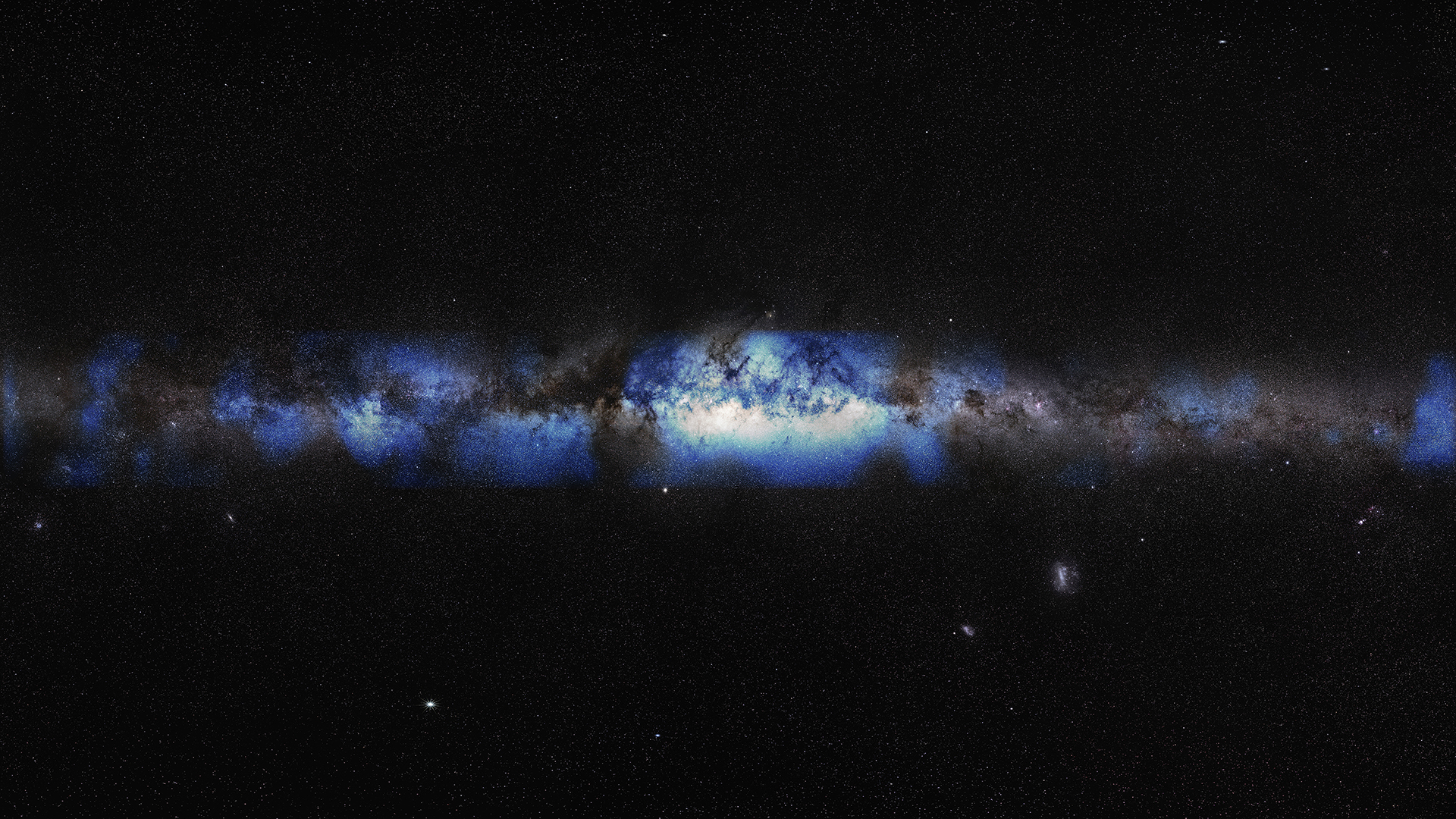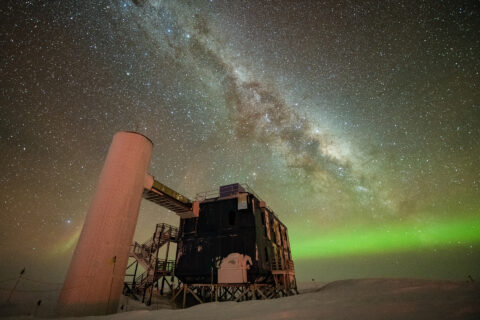Underwater telescope at the South Pole discovers neutrinos from the Milky Way
Our cosmic home in a new light
The origins of a high-energy shower of relativistic particles that is constantly impacting the Earth’s atmosphere is one of the greatest mysteries of modern astroparticle physics. An international team of researchers is now unlocking this mystery. With the IceCube detector at the Earth’s South Pole, they have been able to detect neutrinos from our Milky Way for the first time.
Astrophysicists from FAU were also involved in the IceCube collaboration.
Seeing our galaxy, the Milky Way, in summer in a dark location is one of the most impressive experiences of nature for many people. Even when viewed by the naked eye, the light glimmer of a line of stars punctuated by dark clouds stretching across the night sky provides a glimpse of the many billions of stars that populate our galaxy.
Even if we were only able to unlock the secrets behind the structure of our galaxy in modern times, being able to see the Milky Way in visible light has been part of our natural heritage since antiquity. With the IceCube Neutrino Observatory, researchers have now been able to generate an image of the Milky Way using neutrinos, which are intensely penetrating elementary particles produced in extremely high-energy processes.
They now have published their findings in the specialist journal Science.
“What’s intriguing is that, unlike the case for light of any wavelength in the electromagnetic spectrum, in neutrinos, the distant universe outshines the nearby sources in our own galaxy. The collaboration of several outstanding scientists from many different disciplines was therefore required in order to discover our own galaxy,” says Francis Halzen, Professor at the University of Wisconsin in Madison and Principal Investigator of IceCube.
Neutrino messengers from other galaxies
However, the energy from the neutrinos now detected by IceCube is millions or billions of times greater than the energy from the constant flow of such particles that reach us from fusion reactions in the core of our Sun. The neutrinos that have now been detected clearly do not originate from the stars in the Milky Way itself, but give us a glimpse of extremely energetic particles, known as cosmic rays, that permeate the space between the stars and also constantly impact with the atmosphere of our Earth.
The IceCube Neutrino Observatory, a detector operating at the Amundsen-Scott South Pole Station, comprises a cubic kilometer of Antarctic ice into which over 5000 light-sensitive sensors have been installed.
Even though almost all neutrinos penetrate the matter around us almost without disruption, sometimes they do interact in or around the block of ice after their long journey through the universe. This can give rise to charged elementary particles such as electrons, which emit short bursts of light in the highly transparent ice, revealing the neutrino and its approximate origins.
Due to observations of cosmic rays and also of extremely energetic photons (gamma rays) from the Milky Way, researchers predict that it should be possible to detect neutrinos from the Milky Way as they are almost inevitably generated during the interaction of energy-rich protons and other atomic nuclei, for example, with the gas and dust in the space between the stars.
Breakthrough for neutrino research thanks to AI
Researchers discovered that our Milky Way is not a very strong source of neutrinos, but that there were several significant hurdles that had to be overcome before they could filter our the very weak signal from all the background noise.
To overcome these hurdles, researchers from Drexel University (USA) developed analyses that search for “cascade” events where the energy of the original neutrino is deposited in a relatively compact and almost spherical region. Since the substrate can describe such events relatively well by means of interactions in our own atmosphere, this selection led to an effectively higher sensitivity for the highly sought after neutrinos from the Milky Way.
However, this alone was still not enough for the first human sighting of a neutrino on our own galaxy. The final breakthrough was only achieved by the use of machine learning methods developed at TU Dortmund and that significantly improved the identification of the cascades generated by the neutrinos and the reconstruction of their direction and energy.
“The development of new methods enabled us to retain over an order of magnitude more neutrino events with better reconstruction of their direction of origin, which means that we were able to increase the sensitivity of IceCube by a factor of three compared to previous searches,” says IceCube member Mirco Hünnefeld, one of the lead analyzers of the dataset and who is currently studying for a doctoral degree in physics at TU Dortmund.

Analysis of 60,000 neutrino observations from 10 years
The dataset used in the study included around 60,000 neutrinos spanning 10 years of IceCube observations, 30 times as many events as the selection used in a previous analysis of the galactic plane using cascade events. These detected neutrino events were compared to previously published maps of locations in the sky where a particularly large number of neutrinos were expected.
The next step is to identify individual neutrino sources within the Milky Way.
These and other questions will be investigated in follow-up analyses that are already planned by the IceCube collaboration. However, it is already clear that the discovery of high-energy neutrinos in the Milky Way will open up entirely new opportunities for studying the most high-energy particles in our cosmic environment and that it represents a major step towards understanding the origins of cosmic rays in the galaxy.
The enormous power of modern machine learning methods offer great potential, bringing other breakthroughs within reach.
This major step for astronomy and astroparticle physics was only made possible by the collaboration of researchers from many different institutions. In Germany, this collaboration involves ten universities and the Helmholtz research centers DESY and KIT.
At FAU, a research team led by Prof. Dr. Claudio Kopper, Chair of Experimental Astroparticle Physics and Prof. Dr. Uli Katz, Chair of Experimental Physics, at the Erlangen Center for Astroparticle Physics, are participating in the collaboration.
Further development of IceCube and the scientific analysis of the collected data is funded with significant contributions from the Federal Ministry of Education and Research (BMBF) and the German Research Foundation (DFG).
Further information
Information by ECAP about IceCube
Prof. Dr. Claudio Kopper
Chair of Experimental Astroparticle Physics
Phone: +49 9131 85 70726
Prof. Dr. Uli Katz
Chair of Experimental Physics
Phone: +49 9131 85 27072
